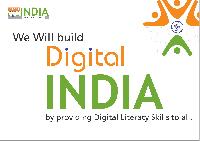
Digital India is an umbrella programme based on technology with a vision to transform India to a digitally empowered society and a knowledge economy. To realize the objectives, the programme has established an ecosystem comprised of several Ministries and government departments, initiatives which are coordinated by the Department of Electronics and Information Technology (DeitY). Delivery of public services through the use of information technology is an important part of Digital India and it makes the initiative as a technology led enabling programme for citizens. The Digital India programme was launched by Prime Minister Narendra Modi on July 1st 2015.
Given the target of transforming the country into a knowledge economy and information society, the initiative needs some preparatory measures. Creation of sufficient physical infrastructure, providing the vital governance services to the people on e-mode and empowering people to handle digital technologies (digital literacy) are the three key areas to prepare for the knowledge economy under Digital India. Following are steps and targets related with these key areas to attain the objectives.
- Digital infrastructure: high speed internet facility, mobile phone and bank account, access to common service centre, internet identity, sharable private space on a public cloud and safe and secure cyberspace.
- Governance and services on demand will be available in real time for online and mobile platforms, seamlessly integrated across departments and jurisdictions. All citizen documents to be made available on the cloud platform so that physical document presentation can be minimized. Cashless electronic transactions and Geographical Information Systems (GIS) will be integrated with the scheme.
- Empower citizens, especially rural citizens, by providing digital literacy.
Digital technologies influence almost all aspects of the economy and society. Hence the programme covers wider areas to make India a digitally empowered country. The Government has identified nine pillars for Digital India.
1. Broadband Highways: Government aims to lay national optical fibre network in all 2.5 lakh gram panchayats. Department of Telecommunications (DoT) is the nodal Department for this project. A new deadline of 2018 has been set for providing broadband internet to all panchayats.
National Information Infrastructure (NII) would integrate the network and cloud infrastructure in the country to provide high speed connectivity and cloud platform to various government departments up to the panchayat level. The infrastructure components for broadband networks includes: State Wide Area Network (SWAN), National Knowledge Network (NKN), National Optical Fibre Network (NOFN), Government User Network (GUN) and the MeghRaj Cloud. DeitY will be the nodal Department for this project.
2. Universal Access to Phones: Mobile phone coverage will be provided to all the remaining 55,619 villages in the country. The Department of Telecommunications will be the nodal department and project cost will be around Rs 16,000 Cr during 2014-18.
3. Public Internet Access Programme: Common Services Centres (CSCs) will be strengthened and their number will be increased so that each Panchayt gets a CSC (total 250000 CSCs). CSCs would be made viable and multi-functional end-points for delivery of government and business services. DeitY would be the nodal department to implement the scheme.
4. e-Governance – Reforming Govt. through technology: Digital technology will be used for the better delivery of government services. The government aims to improve processes and delivery of services through e-Governance with UIDAI, payment gateway, EDI and mobile platforms. School certificates, voter ID cards will be provided online (digi-locker). All databases and information should be in electronic form and not manual.
5. e-Kranti -Electronic Delivery of Services: e-Kranti is an advanced e-governance programme to deliver governance services through electronic mode. It has 44 mission projects. The programme integrates the previous National E-Governance Plan. Public services related to health, education, farmers, justice, security and financial inclusion etc will be administered electronically under e-Kranti.
6. Information to all: information related with governance and public services to citizens will be easily provided to citizens through digital platforms including social media.
7. Electronics, Manufacturing with a target Net Zero Imports: This pillar of Digital India aims to promote the manufacture of digital technology devices especially electronics with the country. Manufacturing of electronics within India will be promoted with a target of net zero import by 2020. For this, several steps under the National Electronic Policy will be used. Taxation incentives, eliminating cost disadvantages, promoting incubators, clusters, skill development etc are some of them.
8. IT for Jobs: This pillar focuses on providing skill and training to the youth for availing employment opportunities in the IT/ITES sector. There are eight components with specific scope of activities under this pillar: focusing on disadvantaged regions- rural areas and North East, training one crore students in IT/ITES Sector, training three lakh service delivery agents etc.
9. Early Harvest Programmes: under this pillar, the Government will set up Wi-Fi facilities in all universities and in public spaces across the country, eBooks will be provided to schools, email will be made the primary mode of communication, Aadhar Enabled Biometric Attendance System will be deployed in all central government offices etc.
*********









